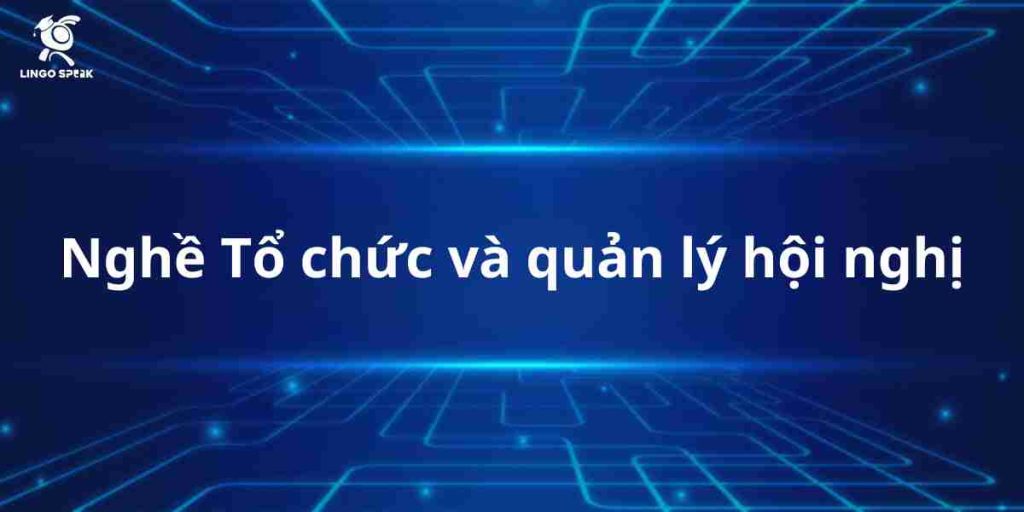Bài viết này cung cấp 100 từ vựng và cụm từ vựng tiếng Anh quan trọng dành cho ngành nghề Tổ chức và Quản lý Hội nghị. Các từ vựng được chọn lọc kỹ lưỡng, giúp bạn nắm bắt dễ dàng các thuật ngữ chuyên ngành, từ đó nâng cao khả năng giao tiếp, làm việc hiệu quả trong môi trường quốc tế.
Từ vựng nghề Quản lý hệ thống thông tin quản trị
- Management Information Systems (MIS): Hệ thống thông tin quản trị
- Information Technology (IT): Công nghệ thông tin
- Database Management System (DBMS): Hệ quản trị cơ sở dữ liệu
- Enterprise Resource Planning (ERP): Lập kế hoạch tài nguyên doanh nghiệp
- Decision Support System (DSS): Hệ thống hỗ trợ quyết định
- Customer Relationship Management (CRM): Quản lý quan hệ khách hàng
- Business Intelligence (BI): Thông tin kinh doanh
- Data Warehousing: Lưu trữ dữ liệu
- Cloud Computing: Điện toán đám mây
- Network Security: Bảo mật mạng
- System Integration: Tích hợp hệ thống
- Information Security: An ninh thông tin
- Data Mining: Khai thác dữ liệu
- IT Governance: Quản trị công nghệ thông tin
- IT Infrastructure: Hạ tầng công nghệ thông tin
- Knowledge Management: Quản lý tri thức
- Business Process Management (BPM): Quản lý quy trình kinh doanh
- Software Development Life Cycle (SDLC): Vòng đời phát triển phần mềm
- System Analysis and Design: Phân tích và thiết kế hệ thống
- Project Management: Quản lý dự án
- Information Systems Audit: Kiểm toán hệ thống thông tin
- Systems Development: Phát triển hệ thống
- Data Governance: Quản trị dữ liệu
- Information Retrieval: Truy xuất thông tin
- IT Service Management: Quản lý dịch vụ công nghệ thông tin
- Enterprise Architecture: Kiến trúc doanh nghiệp
- Data Analytics: Phân tích dữ liệu
- User Interface (UI): Giao diện người dùng
- User Experience (UX): Trải nghiệm người dùng
- System Design: Thiết kế hệ thống
- Application Software: Phần mềm ứng dụng
- Middleware: Phần mềm trung gian
- Data Integration: Tích hợp dữ liệu
- IT Project Management: Quản lý dự án công nghệ thông tin
- Risk Management: Quản lý rủi ro
- Information Systems Management: Quản lý hệ thống thông tin
- Business Continuity Planning: Kế hoạch duy trì hoạt động kinh doanh
- Information Systems Strategy: Chiến lược hệ thống thông tin
- Cloud Storage: Lưu trữ đám mây
- Business Process Automation (BPA): Tự động hóa quy trình kinh doanh
- IT Compliance: Tuân thủ công nghệ thông tin
- Data Encryption: Mã hóa dữ liệu
- Digital Transformation: Chuyển đổi số
- IT Support: Hỗ trợ công nghệ thông tin
- System Monitoring: Giám sát hệ thống
- Change Management: Quản lý thay đổi
- IT Architecture: Kiến trúc công nghệ thông tin
- Business Systems Analysis: Phân tích hệ thống kinh doanh
- System Configuration: Cấu hình hệ thống
- Data Backup: Sao lưu dữ liệu
- Information Systems Design: Thiết kế hệ thống thông tin
- IT Risk Assessment: Đánh giá rủi ro công nghệ thông tin
- Software Engineering: Kỹ thuật phần mềm
- Data Visualization: Trực quan hóa dữ liệu
- Information Systems Implementation: Triển khai hệ thống thông tin
- System Optimization: Tối ưu hóa hệ thống
- Database Administration: Quản trị cơ sở dữ liệu
- Business Analysis: Phân tích kinh doanh
- IT Budgeting: Lập ngân sách công nghệ thông tin
- Technical Support: Hỗ trợ kỹ thuật
- Information Systems Planning: Lập kế hoạch hệ thống thông tin
- System Security: Bảo mật hệ thống
- Application Development: Phát triển ứng dụng
- Data Management: Quản lý dữ liệu
- Information Systems Research: Nghiên cứu hệ thống thông tin
- IT Service Delivery: Cung cấp dịch vụ công nghệ thông tin
- Business Information Systems: Hệ thống thông tin kinh doanh
- IT Infrastructure Management: Quản lý hạ tầng công nghệ thông tin
- Performance Management: Quản lý hiệu suất
- Software Testing: Kiểm tra phần mềm
- Information Systems Maintenance: Bảo trì hệ thống thông tin
- Systems Operations: Vận hành hệ thống
- Network Administration: Quản trị mạng
- Enterprise Software: Phần mềm doanh nghiệp
- Information Systems Lifecycle: Vòng đời hệ thống thông tin
- IT Strategic Planning: Lập kế hoạch chiến lược công nghệ thông tin
- Systems Upgrades: Nâng cấp hệ thống
- Business Analytics: Phân tích kinh doanh
- IT Asset Management: Quản lý tài sản công nghệ thông tin
- System Integration Testing: Kiểm tra tích hợp hệ thống
- Customer Information Systems: Hệ thống thông tin khách hàng
- Data Quality Management: Quản lý chất lượng dữ liệu
- Information Systems Development: Phát triển hệ thống thông tin
- IT Operations Management: Quản lý hoạt động công nghệ thông tin
- IT Systems Integration: Tích hợp hệ thống công nghệ thông tin
- Business Intelligence Tools: Công cụ thông tin kinh doanh
- Information Systems Consulting: Tư vấn hệ thống thông tin
- IT Security Policies: Chính sách bảo mật công nghệ thông tin
- Information Systems Documentation: Tài liệu hệ thống thông tin
- IT Incident Management: Quản lý sự cố công nghệ thông tin
- Systems Performance Analysis: Phân tích hiệu suất hệ thống
- Application Support: Hỗ trợ ứng dụng
- Information Systems Governance: Quản trị hệ thống thông tin
- IT Service Delivery Management: Quản lý cung cấp dịch vụ công nghệ thông tin
- Technology Roadmap: Lộ trình công nghệ
- Business Systems Management: Quản lý hệ thống kinh doanh
- IT Vendor Management: Quản lý nhà cung cấp công nghệ thông tin
- Information Systems Optimization: Tối ưu hóa hệ thống thông tin
- Systems Performance Monitoring: Giám sát hiệu suất hệ thống
- IT Service Catalog: Danh mục dịch vụ công nghệ thông tin
Bài viết sử dụng thuật ngữ trên
- Management Information Systems (MIS): “The company relies on a robust Management Information Systems (MIS) to streamline its operations and decision-making processes.”
- Information Technology (IT): “Information Technology (IT) plays a crucial role in maintaining the efficiency of modern businesses.”
- Database Management System (DBMS): “We use a sophisticated Database Management System (DBMS) to handle our large volumes of data.”
- Enterprise Resource Planning (ERP): “The new Enterprise Resource Planning (ERP) system integrates various business functions into one cohesive platform.”
- Decision Support System (DSS): “The Decision Support System (DSS) helps managers make informed choices by analyzing complex data.”
- Customer Relationship Management (CRM): “Our Customer Relationship Management (CRM) software allows us to track interactions with clients and improve service.”
- Business Intelligence (BI): “Business Intelligence (BI) tools provide valuable insights into market trends and business performance.”
- Data Warehousing: “Data warehousing enables us to store and manage vast amounts of historical data for analysis.”
- Cloud Computing: “Cloud computing offers scalable resources and flexibility for managing IT infrastructure.”
- Network Security: “Network security measures are essential to protect our systems from cyber threats.”
- System Integration: “System integration ensures that different software applications work seamlessly together.”
- Information Security: “Information security protocols are crucial for safeguarding sensitive company data.”
- Data Mining: “Data mining techniques help uncover hidden patterns and insights from large datasets.”
- IT Governance: “IT governance frameworks ensure that IT investments align with business objectives and deliver value.”
- IT Infrastructure: “A strong IT infrastructure supports the effective operation of all technology systems within an organization.”
- Knowledge Management: “Knowledge management systems facilitate the sharing and retention of valuable organizational knowledge.”
- Business Process Management (BPM): “Business Process Management (BPM) tools help optimize and automate core business processes.”
- Software Development Life Cycle (SDLC): “The Software Development Life Cycle (SDLC) provides a structured approach to software development.”
- System Analysis and Design: “System analysis and design involve evaluating business needs and creating solutions to meet those needs.”
- Project Management: “Effective project management ensures that IT projects are completed on time and within budget.”
- Information Systems Audit: “An information systems audit assesses the effectiveness and security of our IT systems.”
- Systems Development: “Systems development involves creating and implementing new software applications.”
- Data Governance: “Data governance policies ensure data quality and compliance with regulations.”
- Information Retrieval: “Information retrieval techniques help quickly access relevant data from large databases.”
- IT Service Management: “IT Service Management (ITSM) frameworks help deliver high-quality IT services to users.”
- Enterprise Architecture: “Enterprise architecture provides a comprehensive framework for aligning IT strategy with business goals.”
- Data Analytics: “Data analytics tools help organizations make data-driven decisions by analyzing trends and patterns.”
- User Interface (UI): “The User Interface (UI) design of our application ensures that it is easy and intuitive for users.”
- User Experience (UX): “User Experience (UX) design focuses on creating a seamless and enjoyable interaction for users.”
- System Design: “System design involves defining the architecture and components of a software system.”
- Application Software: “Application software is used to perform specific tasks such as word processing or data analysis.”
- Middleware: “Middleware facilitates communication and data exchange between different software applications.”
- Data Integration: “Data integration tools combine data from various sources into a unified view.”
- IT Project Management: “IT project management involves planning, executing, and overseeing technology projects.”
- Risk Management: “Risk management practices identify and mitigate potential threats to IT systems.”
- Information Systems Management: “Information Systems Management oversees the implementation and maintenance of IT solutions.”
- Business Continuity Planning: “Business continuity planning ensures that critical operations continue during and after a disaster.”
- Information Systems Strategy: “Developing an Information Systems Strategy aligns IT initiatives with the organization’s overall goals.”
- Cloud Storage: “Cloud storage offers a scalable solution for saving and accessing data from anywhere.”
- Business Process Automation (BPA): “Business Process Automation (BPA) streamlines repetitive tasks to increase efficiency.”
- IT Compliance: “IT compliance ensures that technology practices adhere to regulatory and internal standards.”
- Data Encryption: “Data encryption protects sensitive information by converting it into an unreadable format.”
- Digital Transformation: “Digital transformation involves integrating digital technologies into all areas of a business.”
- IT Support: “IT support provides assistance with technology-related issues and maintenance.”
- System Monitoring: “System monitoring tools track the performance and health of IT systems.”
- Change Management: “Change management processes help manage and communicate changes in IT systems and policies.”
- IT Architecture: “IT architecture outlines the structure and design of an organization’s technology systems.”
- Business Systems Analysis: “Business systems analysis evaluates and improves the efficiency of business processes through technology.”
- System Configuration: “System configuration involves setting up hardware and software to meet specific requirements.”
- Data Backup: “Regular data backup ensures that information is preserved in case of data loss or corruption.”
- Information Systems Design: “Information Systems Design focuses on creating effective IT solutions for business needs.”
- IT Risk Assessment: “IT risk assessment identifies potential risks and vulnerabilities in technology systems.”
- Software Engineering: “Software engineering involves designing and developing software applications using engineering principles.”
- Data Visualization: “Data visualization techniques help present data in graphical formats for better understanding.”
- Information Systems Implementation: “Information Systems Implementation involves deploying new technology solutions within an organization.”
- System Optimization: “System optimization improves the performance and efficiency of IT systems.”
- Database Administration: “Database administration manages and maintains databases to ensure their reliability and performance.”
- Business Analysis: “Business analysis involves identifying business needs and determining technology solutions to address them.”
- IT Budgeting: “IT budgeting allocates financial resources for technology investments and operations.”
- Technical Support: “Technical support provides assistance with troubleshooting and resolving IT issues.”
- Information Systems Planning: “Information Systems Planning involves developing strategies for implementing and managing IT solutions.”
- System Security: “System security measures protect IT infrastructure from unauthorized access and cyber threats.”
- Application Development: “Application development creates software applications that meet user requirements.”
- Data Management: “Data management encompasses the processes of collecting, storing, and using data efficiently.”
- Information Systems Research: “Information Systems Research explores new technologies and methodologies for improving IT systems.”
- IT Service Delivery: “IT service delivery ensures that technology services are provided effectively and efficiently.”
- Business Information Systems: “Business Information Systems support various business functions, such as finance and operations.”
- IT Infrastructure Management: “IT Infrastructure Management oversees the hardware and software resources used in technology operations.”
- Performance Management: “Performance management evaluates and improves the effectiveness of IT systems and services.”
- Software Testing: “Software testing identifies defects and ensures that applications function as intended.”
- Information Systems Maintenance: “Information Systems Maintenance involves updating and repairing IT systems to ensure their reliability.”
- Systems Operations: “Systems operations manage the day-to-day activities required to keep IT systems running smoothly.”
- Network Administration: “Network administration handles the setup and maintenance of computer networks.”
- Enterprise Software: “Enterprise software supports large-scale business processes and operations.”
- Information Systems Lifecycle: “The Information Systems Lifecycle covers the phases from planning and development to implementation and maintenance.”
- IT Strategic Planning: “IT Strategic Planning aligns technology initiatives with long-term business objectives.”
- Systems Upgrades: “Systems upgrades enhance the functionality and performance of existing IT systems.”
- Business Analytics: “Business analytics uses data to identify trends and make informed decisions.”
- IT Asset Management: “IT Asset Management tracks and manages the company’s technology assets.”
- System Integration Testing: “System Integration Testing ensures that different systems work together as expected.”
- Customer Information Systems: “Customer Information Systems manage and analyze customer data to improve service.”
- Data Quality Management: “Data Quality Management ensures that data is accurate, complete, and reliable.”
- Information Systems Development: “Information Systems Development creates and implements new IT solutions.”
- IT Operations Management: “IT Operations Management oversees the daily activities and maintenance of technology systems.”
- IT Systems Integration: “IT Systems Integration combines various IT systems to work together effectively.”
- Business Intelligence Tools: “Business Intelligence Tools help analyze and visualize business data to support decision-making.”
- Information Systems Consulting: “Information Systems Consulting provides expert advice on implementing and managing IT systems.”
- IT Security Policies: “IT Security Policies establish guidelines for protecting technology systems and data.”
- Information Systems Documentation: “Information Systems Documentation includes manuals and guides for using and maintaining IT systems.”
- IT Incident Management: “IT Incident Management addresses and resolves technology-related issues and disruptions.”
- Systems Performance Analysis: “Systems Performance Analysis evaluates how well IT systems meet performance expectations.”
- Application Support: “Application Support provides help with software applications to ensure their proper functioning.”
- Information Systems Governance: “Information Systems Governance ensures that IT systems align with business goals and comply with regulations.”
- IT Service Delivery Management: “IT Service Delivery Management oversees the delivery of technology services to meet user needs.”
- Technology Roadmap: “A Technology Roadmap outlines the future direction and plans for technology development.”
- Business Systems Management: “Business Systems Management involves overseeing and improving technology systems used in business operations.”
- IT Vendor Management: “IT Vendor Management handles relationships and contracts with technology service providers.”
- Information Systems Optimization: “Information Systems Optimization enhances the efficiency and performance of IT systems.”
- Systems Performance Monitoring: “Systems Performance Monitoring tracks the effectiveness and health of IT systems.”
- IT Service Catalog: “An IT Service Catalog lists the available technology services and their details for users.”
Bài tập
- The company implemented a new __________ to improve its data management and decision-making processes.
- Effective __________ is crucial for maintaining the efficiency of modern technology systems.
- Our __________ helps us manage and organize large volumes of data efficiently.
- The new __________ system integrates various business functions into a single platform.
- A __________ can assist in making informed choices by analyzing complex data.
- We use __________ software to track customer interactions and improve service.
- __________ tools provide valuable insights into market trends and business performance.
- __________ allows us to store and manage historical data for future analysis.
- __________ offers scalable resources and flexibility for managing IT infrastructure.
- Ensuring __________ is essential to protect our systems from potential cyber threats.
- __________ ensures that different software applications work seamlessly together.
- Implementing __________ protocols is crucial for safeguarding sensitive company information.
- __________ techniques help uncover patterns and insights from large datasets.
- __________ frameworks ensure that IT investments align with business objectives and deliver value.
- A strong __________ supports the effective operation of all technology systems within the organization.
- __________ systems facilitate the sharing and retention of valuable organizational knowledge.
- __________ tools help automate and optimize core business processes.
- The __________ provides a structured approach to software development from conception to deployment.
- __________ involves evaluating business needs and designing solutions to meet those needs.
- Successful __________ ensures that IT projects are completed on time and within budget.
- An __________ assesses the effectiveness and security of our IT systems.
- __________ involves creating and implementing new software applications to meet business needs.
- __________ policies ensure that data is accurate, secure, and properly managed.
- __________ methods help quickly access relevant information from large databases.
- __________ frameworks help deliver high-quality IT services to users.
- __________ provides a comprehensive framework for aligning IT strategy with business goals.
- __________ tools analyze trends and patterns to support decision-making.
- The __________ of data from various sources helps in creating a unified view.
- __________ involves planning, executing, and overseeing technology projects.
- Effective __________ practices help identify and mitigate potential risks to IT systems.
- __________ oversees the implementation and maintenance of IT solutions within an organization.
- __________ ensures that critical business functions continue during and after a disaster.
- Developing an __________ aligns IT initiatives with the organization’s overall goals and objectives.
- __________ offers a scalable solution for saving and accessing data from any location.
- __________ streamlines repetitive tasks to increase efficiency across business processes.
- __________ ensures that technology practices adhere to regulatory and internal standards.
- __________ protects sensitive data by converting it into an unreadable format.
- __________ involves integrating digital technologies into all areas of a business.
- __________ provides assistance with technology-related issues and maintenance.
- __________ tools track the performance and health of IT systems.
- __________ processes help manage and communicate changes in IT systems and policies.
- __________ outlines the structure and design of an organization’s technology systems.
- __________ evaluates and improves the efficiency of business processes through technology.
- __________ involves setting up hardware and software to meet specific requirements.
- Regular __________ ensures that information is preserved in case of data loss or corruption.
- __________ focuses on creating effective IT solutions to address business needs.
- __________ identifies potential risks and vulnerabilities in technology systems.
- __________ involves designing and developing software applications using engineering principles.
- __________ helps present data in graphical formats for better understanding.
- __________ involves deploying new technology solutions within an organization.
- __________ improves the performance and efficiency of IT systems.
- __________ manages and maintains databases to ensure their reliability and performance.
- __________ involves identifying business needs and determining technology solutions.
- __________ allocates financial resources for technology investments and operations.
- __________ provides help with troubleshooting and resolving IT issues.
- __________ involves developing strategies for implementing and managing IT solutions.
- __________ measures protect IT infrastructure from unauthorized access and cyber threats.
- __________ creates software applications that meet user requirements.
- __________ encompasses the processes of collecting, storing, and using data effectively.
- __________ explores new technologies and methodologies for improving IT systems.
- __________ ensures that technology services are provided effectively and efficiently.
- __________ supports various business functions, such as finance and operations.
- __________ oversees the hardware and software resources used in technology operations.
- __________ evaluates and improves the effectiveness of IT systems and services.
- __________ identifies defects and ensures that applications function as intended.
- __________ involves updating and repairing IT systems to ensure their reliability.
- __________ manages the day-to-day activities required to keep IT systems running smoothly.
- __________ handles the setup and maintenance of computer networks.
- __________ supports large-scale business processes and operations.
- The __________ covers the phases from planning and development to implementation and maintenance.
- __________ aligns technology initiatives with long-term business objectives.
- __________ enhances the functionality and performance of existing IT systems.
- __________ uses data to identify trends and make informed decisions.
- __________ tracks and manages the company’s technology assets.
- __________ ensures that different systems work together as expected.
- __________ manages and analyzes customer data to improve service.
- __________ ensures that data is accurate, complete, and reliable.
- __________ creates and implements new IT solutions to meet business needs.
- __________ oversees the daily activities and maintenance of technology systems.
- __________ combines various IT systems to work together effectively.
- __________ helps analyze and visualize business data to support decision-making.
- __________ provides expert advice on implementing and managing IT systems.
- __________ establishes guidelines for protecting technology systems and data.
- __________ includes manuals and guides for using and maintaining IT systems.
- __________ addresses and resolves technology-related issues and disruptions.
- __________ evaluates how well IT systems meet performance expectations.
- __________ provides assistance with software applications to ensure their proper functioning.
- __________ ensures that IT systems align with business goals and comply with regulations.
- __________ oversees the delivery of technology services to meet user needs.
- The __________ outlines the future direction and plans for technology development.
- __________ involves overseeing and improving technology systems used in business operations.
- __________ handles relationships and contracts with technology service providers.
- __________ enhances the efficiency and performance of IT systems.
- __________ tracks the effectiveness and health of IT systems.
- An __________ lists the available technology services and their details for users.
- __________ involves managing the company’s technology assets effectively.
- __________ involves integrating various IT systems to work together seamlessly.
- __________ provides a structured approach to developing software applications.
- __________ ensures that all technology systems work together to meet business needs.
- __________ identifies and addresses issues with IT systems to maintain service quality.
Đáp án
- Management Information Systems (MIS)
- Information Technology (IT)
- Database Management System (DBMS)
- Enterprise Resource Planning (ERP)
- Decision Support System (DSS)
- Customer Relationship Management (CRM)
- Business Intelligence (BI)
- Data Warehousing
- Cloud Computing
- Network Security
- System Integration
- Information Security
- Data Mining
- IT Governance
- IT Infrastructure
- Knowledge Management
- Business Process Management (BPM)
- Software Development Life Cycle (SDLC)
- System Analysis and Design
- Project Management
- Information Systems Audit
- Systems Development
- Data Governance
- Information Retrieval
- IT Service Management (ITSM)
- Enterprise Architecture
- Data Analytics
- Data Integration
- IT Project Management
- Risk Management
- Information Systems Management
- Business Continuity Planning
- Information Systems Strategy
- Cloud Storage
- Business Process Automation (BPA)
- IT Compliance
- Data Encryption
- Digital Transformation
- IT Support
- System Monitoring
- Change Management
- IT Architecture
- Business Systems Analysis
- System Configuration
- Data Backup
- Information Systems Design
- IT Risk Assessment
- Software Engineering
- Data Visualization
- Information Systems Implementation
- System Optimization
- Database Administration
- Business Analysis
- IT Budgeting
- Technical Support
- Information Systems Planning
- System Security
- Application Development
- Data Management
- Information Systems Research
- IT Service Delivery
- Business Information Systems
- IT Infrastructure Management
- Performance Management
- Software Testing
- Information Systems Maintenance
- Systems Operations
- Network Administration
- Enterprise Software
- Information Systems Lifecycle
- IT Strategic Planning
- Systems Upgrades
- Business Analytics
- IT Asset Management
- System Integration Testing
- Customer Information Systems
- Data Quality Management
- Information Systems Development
- IT Operations Management
- IT Systems Integration
- Business Intelligence Tools
- Information Systems Consulting
- IT Security Policies
- Information Systems Documentation
- IT Incident Management
- Systems Performance Analysis
- Application Support
- Information Systems Governance
- IT Service Delivery Management
- Technology Roadmap
- Business Systems Management
- IT Vendor Management
- Information Systems Optimization
- Systems Performance Monitoring
- IT Service Catalog
- IT Asset Management
- IT Systems Integration
- Software Development Life Cycle (SDLC)
- System Integration
- IT Incident Management











